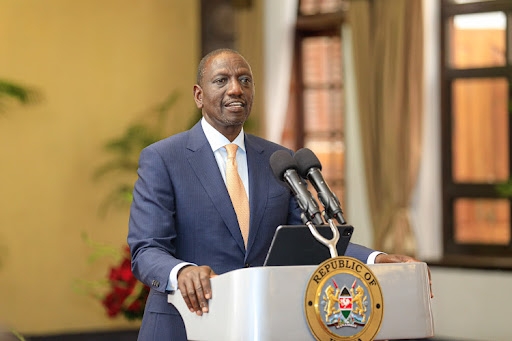Efforts by the state to revamp City Park have started paying off with an increase in the number of visitors.
Thuo Fiu, the chairman of City Park Community Forest Association, told the Star on Thursday that the 63-hectare (155 acres) park is regaining its lost glory.
“We receive an average of 2,000 visitors on Saturday and Sunday. During holidays, we receive 5,000 people. The numbers have been increasing by 20 per cent,” he said.
Nestled within Parklands and four kilometres from the Central Business District, City Park boasts of about 998 tree and plant species.
The park is home to monkeys, the secret slavery, ticked honeybees, butterflies and more than 100 species of birds.
This is according to an assessment by the National Museums of Kenya.
The park also stores Kenya’s history including Mtego wa Panya Maze, Kibagare river, botanical gardens, the Jewish Goan Cemetery and World War 1 and 2 veterans' graves.
Joseph Zuzarte Murumbi’s grave and that of his wife Sheila are hosted at the park.
Murumbi served as Kenya’s second vice president under President Jomo Kenyatta, his close friend.
Murumbi in his will had asked to be buried next to his best friend Pio Gama Pinto.
However, the City Park cemetery where Pinto, a Goan, had been buried was full on June 22, 1990, when Murumbi died.
Jomo Kenyatta had asked that an acre of the park be set aside near Pinto’s grave for Murumbi’s burial.
This is what is currently the Murumbi Memorial Garden which until recently had been neglected, creating a haven for crime.
Following the neglect, thickets of thorny overgrown bougainvillea plants had taken over.
The graves of Murumbi and his wife Sheila had sunk into the ground, and some of the sculptures erected in memory of the art-loving family had been vandalised.
Reports of muggings, killings, violence and drug abuse became synonymous with parts of the park.
As illegal activities rose, the park lost its glory and residents and tourists shunned it.
Land grabbers also stole chunks of the lucrative land.
It is this neglect that prompted the national government to take over the park from the county.
In May 2020, through a directive by President Uhuru Kenyatta, City Park forest was formally placed under the Kenya Forest Service to improve its management and conservation.
City Park was wrestled from the management of Nairobi county and its management placed under KFS in June 2020.
The Kenya Forestry Research Institute was tasked with being in charge of research and development and together with the National Museums of Kenya established a module on the national botanical garden.
The National Museums of Kenya became responsible for the protection of national heritage and historical sites within City Park.
KFS has since deployed rangers to City Park to strengthen security.
“We are currently in the process of formulating a Participatory Forest Management Plan with Kenya Forest Service. The plan, which should be ready by end of the month will help us rehabilitate the park in a structured manner once it has been signed,” Fiu said.
Participatory Forest Management is an approach that deliberately involves adjacent communities and stakeholders in the management of forests within a framework, which contributes to the community’s livelihoods.
Fiu said a forest management agreement will then be signed between CFA and KFS for management of a state or local authority forest.
“We plan to do a mega clean-up exercise to manage litter and sewer coming from Parklands through Kibagare River, which cuts through the park. The clean-up also targets City Park Market,” he said.
Fiu said a social-economic survey, forest survey, as well as the park’s resource map have been done.
This, he said, will aid in decision-making as the needs of those visiting the park, their preferences and population has been identified.
Already, clean-up has started in graveyards and overgrown thickets have been brought under control.
Fiu said despite the strides, the park faces threats of uncontrolled access as the park is not fenced.
He also said some schools and a club have encroached the park.
However, KFS is engaging to find a way forward, while stumping authority to ensure that the secure area is not encroached on.
The National Environment Management Authority has also been roped in to help resolve the threat of pollution.
Fiu said security has also improved owing to the presence of rangers.
KFS chief Conservator of Forests Julius Kamau said KFS is working closely with the Nairobi Metropolitan Services to spruce the park.
He said the five-year Participatory Forest Management Plan is key in resource mobilisation. “We will protect the Park from further encroachment.”
Kamau said a forest station manager and rangers have since been deployed. “They work closely with the Community Forest Association.”
He said CFAs have played a key role in protection, conservation and rehabilitation of forests in the country.
Through CFAs, forest-adjacent communities and other stakeholders are engaged in the co-management of forests in a way that communities benefit.
Forest laws also allow CFAs with various forest user rights, such as firewood and controlled grazing.
The CFAs are also involved in re-afforestation and rehabilitation programmes, which entail as the establishment of tree nurseries, planting and other silvicultural operations through contractual engagements.
Kamau says well-organised and structured CFAs have employed community scouts, who complement KFS rangers in protecting forest resources and in the process, they earn a living.
To date, there are 255 registered CFAs across the country, with 163 having approved Participatory Forest Management Plans and 102 signed Forest Management Agreements between KFS and CFA.
(Edited by Bilha Makokha)
“WATCH: The latest videos from the Star”











